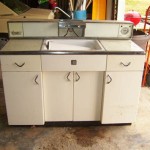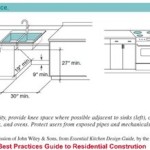How to Replace Kitchen Floor Tiles Without Removing Cabinets
Replacing kitchen floor tiles can significantly enhance the look and feel of your space. However, the prospect of removing cabinets can seem daunting, especially if they are heavy or custom-built. Fortunately, you can replace kitchen floor tiles without removing your cabinets, making the process easier and less disruptive. This article will guide you through the process, highlighting the key steps and considerations.
1. Preparation and Planning
Before starting any renovation project, thorough planning is crucial. Replacing kitchen floor tiles without removing cabinets requires meticulous preparation to ensure a smooth and successful outcome. Here's a step-by-step guide to get you started:
A. Assess the Existing Tile and Subfloor: Examine the current floor tiles and the subfloor beneath them. If the subfloor is damaged or uneven, you may need to address these issues before installing new tiles. Check for moisture damage, rot, or structural weaknesses.
B. Measure the Area: Accurately measure the area where you will be installing the new tiles. Consider the size of your existing cabinets and leave enough space for any necessary cuts. Make sure to account for any existing tile spacers or grout lines when determining the exact quantities of new tiles needed.
C. Choose the Right Tiles: Select tiles that complement your kitchen's style and color scheme. If you're using a similar size and thickness to the existing tiles, the installation process will be relatively straightforward. However, if you're opting for a different size or type of tile, consider the overall design and aesthetic impact on your countertop and cabinets.
D. Gather Necessary Tools and Materials: Ensure you have all the necessary tools and materials before starting the project. These may include a tile saw, grout float, grout remover, tile spacers, trowel, grout, mortar, cleaning supplies, and any other equipment specific to your chosen tile type.
E. Protect Surrounding Areas: Cover your cabinets, countertops, and other furniture with drop cloths or plastic sheeting to protect them from dust, debris, and potential damage. This will ensure a cleaner workspace and prevent any unnecessary accidents.
2. Installing the New Floor Tiles
Once you have completed the preparatory steps, it's time to install the new floor tiles. This process involves careful planning, meticulous cutting, and ensuring correct spacing and alignment. Here's a breakdown of the essential steps:
A. Prepare the Subfloor: Clean the existing subfloor thoroughly to remove dirt, debris, and any loose particles. If required, use a leveling compound to create a smooth and even surface. Ensure the subfloor is dry before proceeding with the tile installation.
B. Apply Mortar: Use a trowel to apply mortar to the subfloor. Spread it evenly and comb it with the notch side of the trowel to create a consistent thickness. The size of the notch on the trowel will vary depending on the size and type of tile you're using.
C. Lay the Tiles: Begin laying the tiles in the center of the room, working your way outwards. Press down firmly to ensure that they are securely attached to the mortar. Maintain consistent spacing between the tiles using tile spacers.
D. Cut Tiles for Cabinets: Carefully measure the space between the cabinets and the walls. Use a tile saw to cut the tiles to fill these areas precisely. Be sure to wear protective eyewear and gloves during this process.
E. Wait for the Mortar to Dry: Allow the mortar to dry completely before proceeding to the next step. This will typically take 24 to 48 hours. Consult the manufacturer's instructions for specific drying times.
3. Grouting and Finishing
Grouting is the final step in completing your new kitchen floor tile installation. It seals the gaps between the tiles, creating a smooth and finished look. Here's how to apply grout effectively:
A. Clean the Tiles: Use a damp sponge to wipe away any excess mortar or debris from the tile surface. This will ensure that the grout adheres properly and prevents any discoloration.
B. Apply Grout: Using a rubber grout float, apply grout to the gaps between the tiles. Press the grout firmly into the spaces, ensuring that it is level and consistent.
C. Remove Excess Grout: Wipe away any excess grout from the tile surfaces with a damp sponge. Work in small sections and rinse the sponge frequently to prevent the grout from drying and becoming difficult to remove.
D. Allow the Grout to Dry: Allow the grout to dry according to the manufacturer's instructions. It will typically take 24 to 48 hours to cure completely. Once dry, polish the tiles with a clean cloth to enhance their shine.
E. Seal the Grout: Apply a sealant to protect the grout from stains and water damage. This will help to preserve the appearance of your new kitchen floor and extend its lifespan.
Successfully replacing kitchen floor tiles without removing cabinets requires careful planning, patience, and attention to detail. By following these steps, you can achieve a professional-looking result and enjoy a beautiful and durable kitchen floor that complements your existing cabinets.

Can You Replace Kitchen Flooring Without Removing Cabinets

How To Remove Tile Floors The Harper House

Tips For Installing A Kitchen Vinyl Tile Floor Merrypad

Replacing Kitchen Tiles Without Removing Cabinets

Tearing Out Old Kitchen Flooring Planitdiy

Replacing Kitchen Tiles Without Removing Cabinets

Can You Replace Kitchen Flooring Without Removing Cabinets Steiner Homes Ltd
Ideas For Covering Up Tile Floors Without Removing It The Decor Formula

Diy Flooring How We Changed Our Kitchen In 3 Days For Less Than 400 Noting Grace

How To Replace Kitchen Tiles Without Removing Cabinets Flooring
Related Posts








